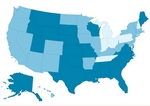profession
Teen girls advised to see a gynecologist before age 16
■ The initial visit should focus on an individual's needs, medical history, physical and emotional development. It also should provide information on reproductive services.
By Tanya Albert Henry — Posted July 16, 2010
Young women should first see a gynecologist between age 13 and 15, and the visit should focus primarily on education and guidance, according to an updated Committee Opinion by the American College of Obstetricians and Gynecologists.
The initial visit should not include a pelvic exam or a speculum exam unless there is a medical reason for one or both, states the four-page opinion in the July Obstetrics & Gynecology.
St. Louis ob-gyn Diane F. Merritt, MD, chair of ACOG's Committee on Adolescent Health Care, said the minute she tells a new teen patient that a Pap smear is unnecessary, "everything changes. That glassy or sullen look dissipates and the mother's shoulders relax."
"I've always tried to make the first visit to the gynecologist a learning experience that is age appropriate," she said. "Let up on these kids. Let them come in and ask questions. Teach them about their body. Teach them about their anatomy. Teach them good hygiene."
Guidelines advising when teens should first visit an ob-gyn were initially issued in 2006. ACOG reissued and updated them because recommendations on HPV vaccines and Pap smears changed, Dr. Merritt said.
ACOG now recommends that healthy women don't need their first Pap test until they are 21 years old. Previously, cervical screenings were recommended three years after their first sexual intercourse or by age 21, whichever occurred first.
Dr. Merritt noted that Pap smears are not needed to prescribe birth control, and physicians can use a urine sample to screen for chlamydia and gonorrhea.
The scope of the first reproductive health visit should depend on an individual's needs, medical history, physical and emotional development, and level of care she receives from other health care professionals, according to the Committee Opinion. Other issues that can be addressed at the first visit include puberty, normal menstruation, healthy eating habits, pregnancy prevention and sexual orientation (link).
Adolescent girls may need two "well-child" visits -- a general preventive visit and a dedicated reproductive health visit to a gynecologist, according to ACOG. Insurers should cover both visits, the ACOG opinion states.
ACOG President Richard N. Waldman, MD, said in a statement that "we encourage parents and guardians to look at this initial visit as a prime opportunity for young girls to meet with us so that we may help alleviate any fears, dispel myths and really start off on the right foot in creating a healthy doctor-patient relationship."












